
 IntroductionThe Astorius is an add on speaker stand that doubles as a speaker module that converts my Asterion design into a tower three way speaker. I designed two different versions and each has a unique sound. The original version uses the bass section of the Alpheus design (Seas L22RN4X/P) including the original low pass filter and the second version uses the bass section of the Daedalus design including the original low pass filter. The L22 version has a cabinet that matches the footprint of the Asterion design and still retains the same original volume and port tuning as used in the Alpheus design. There are two cabinet versions for the RS225, one that uses a cabinet that is the same width and height except is 3" deeper with the port on the front (10"Wx24"Hx18"D) and one that uses a cabinet that is the same depth and height except is 2" wider (12"Wx24"Hx15"D) with the port on the back.The main advantage to these designs over the Asterions by themselves is the lowered distortion below 200 Hz of the larger 8" driver. The L22 has a toned down lower midrange which removes some of the emphasis that was a problem with the original Asterion design. The bass really isn't that much deeper but it is more focused and better defined. The RS version still has the midrange warmth of the original design but has a stronger bass response. Considering that their cost is just a fraction of the cost of the Asterions they should make a great addition and it is fun to compare the sound of the original design to the three way versions and then decide which you like better... personally I like the three way versions. I'm not sure which of the three way versions that I prefer because each has its merits... I like the more balanced midrange of the L22 but prefer the added bass response of the RS version. I guess it all depends on what type of sound you prefer and what type of music you listen to most but I would have to say that for rock music the RS version is the winner and for Jazz I might prefer the L22 version. 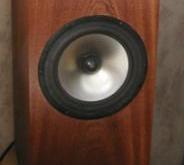 DriversSeas L22RN4X/P (H1208) 8" aluminum woofer The L22RN4X/P is an 8" cone driver with a extremely stiff and stable injection moulded metal basket to keep the critical components in perfect alignment. Large windows in the basket both above and below the spider reduce sound reflection, air flow noise and cavity resonance to a minimum. The extremely stiff aluminum cone gives tremendous bass precision. The cone and the low loss rubber surround show no sign of the familiar cone edge resonance and distortion associated with soft cones. On the other hand, the cone break up modes at higher frequencies call for special attention in the crossover design work. A 4-layer, extremely long, high temperature voice coil wound on an aluminum voice coil former gives a high power handling capacity. The phase plug reduces compression due to temperature variations in the voice coil, eliminates resonances that would occur in the volume between the dust cap and the pole piece and increases the power handling capacity. The large magnet system provides reasonably high efficiency and low Q.Dayton RS225S-8 - The Dayton Reference Series sets a new standard of value in high-performance loudspeaker drivers. Utilizing a low-distortion motor system with two short-circuit paths and a rigid aluminum cone, the Reference Series can outperform drivers that cost several times the price. Their low-distortion characteristics and high excursion capabilities provide exceptional clarity, detail, and dynamics. Woofers feature a shielded motor system, black anodized cone, heavy-duty 6-hole cast frame, low-loss rubber surround, and solid aluminum phase plug. The Dayton RS225 has a power handling of 80W RMS/120W peak, an Fs of 27 Hz, an xmax of 7mm, and a sensitivity of 88.1dB@2.83V/1m. Cabinet DesignThe cabinet height is 24" which puts the Asterion tweeter at or slightly above ear level which is ideal. I would line the cabinets with 2.5" convoluted foam and use a light amount of stuffing behind the woofer. I used three sets of binding posts on the back of the cabinet including a single set that connects to the output of the high pass filter. A jumper cable between this set and the input of the Asterion should be used. The outer two sets of binding posts are part of a bi-amp terminal that includes jumpers. The bottom pair should go to the woofer low pass filter circuit and the top pair should go to the input of the high pass filter. With the jumpers connected the entire speaker can be driven by one amp. With the jumpers removed you can bi-amp the speakers by sending one amp to the bass driver and the other amp to the high pass filter. Bi-amping allows you to adjust the bass level independently if desired just by adjusting the level of the bass driver amplifier relative to the high pass filter amplifier. This may be an advantage to fine tune the designs to suit your tastes because the L22 version is a bit thin and the RS version is the opposite.Astorius with L22For the cabinet I retained the original 40 liter volume of the Alpheus bass design and designed a cabinet that matches the footprint of the Asterion (10" wide x 15" deep). The simulated f3 of this speaker is around 30 Hz.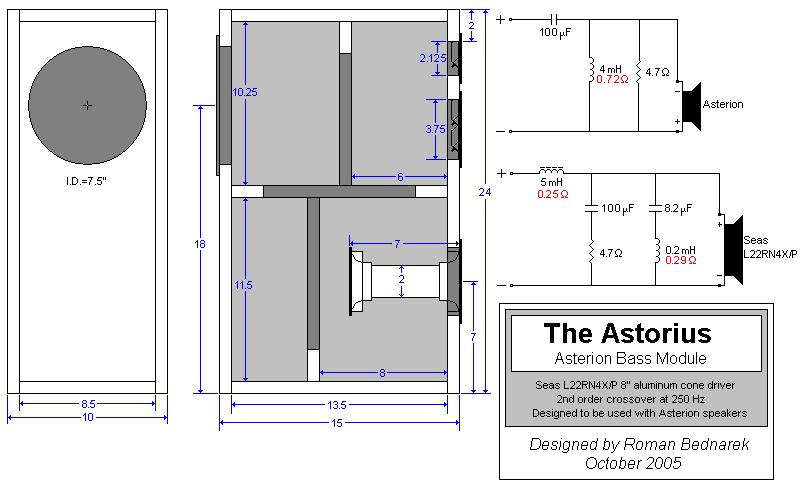
Astorius with RS225 - deep versionFor the cabinet I retained the original 50 liter volume of the Daedlus bass design and designed a cabinet that is 3" deeper than the L22 version (10" wide x 18" deep). Like the L22 version, the simulated f3 of this speaker is also around 30 Hz.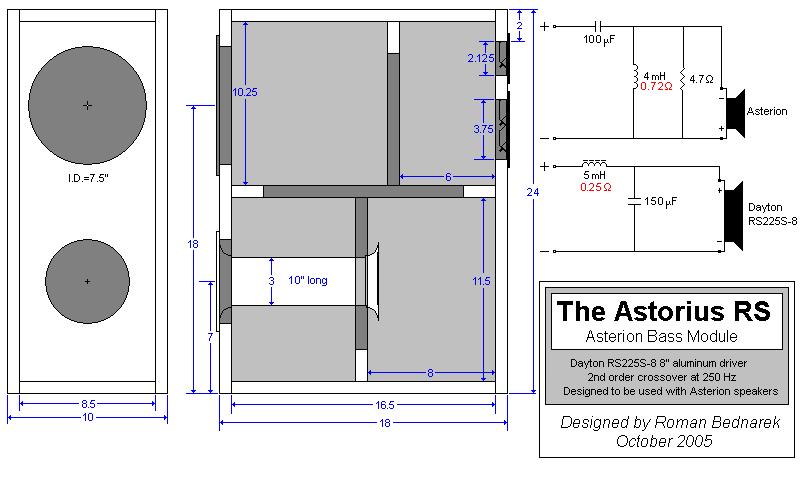
Astorius with RS225 - wide versionFor the cabinet I retained the original 50 liter volume of the Daedlus bass design and designed a cabinet that is 2" wider than the L22 version (12" wide x 15" deep). Like the L22 version, the simulated f3 of this speaker is also around 30 Hz.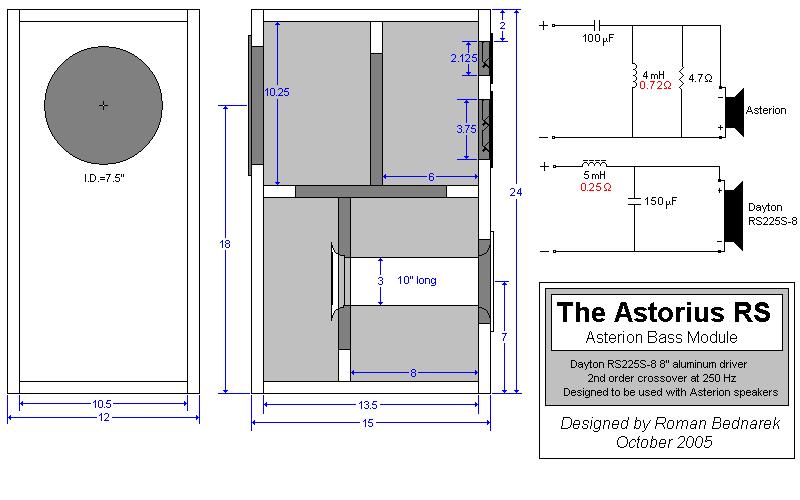
Crossover DesignAstorius with L22I basically used the original Alpheus low pass filter for the bass unit. I would recommend using a 16 gauge steel core inductor for the 5 mH value and a 15 gauge air core inductor for the 5 mH value. I would use 100 uF metallized polypropylene capacitors for both filters and the Dayton line offers good value and cost around $20 each (so that's about $80 in caps for the pair... I suppose if you wanted to save some money you could use electrolytics on the woofer filter but I would stick with metallized poly for the high pass filter). For the 4.7 ohm values I would use 9.1 & 10 ohm 10W non-inductive resistors in parallel. I actually used the Alpheus speakers to design this system and haven't actually built this cabinet. I created a high pass filter to be connected to the Asterions and provide good integration with the L22 response.A plot of the responses is below. The purple trace is the original Asterion two-way design and the black trace is the three way version with the Astorius bass unit. The green trace represents the L22 output, the blue trace represents the filtered Asterion Vifa XT18 output and the red trace represents the filtered Hiquphon OW1 response. The crossover point is about 250 Hz and the slopes are 2nd order so the Asterion must be connected out of phase. The L22 response above 1kHz is probably a bit inaccurate due to the nearfield measurement and I would suspect that the actual output levels are lower in this region (see the Alpheus project for a more accurate plot of the L22 response). The impedance is nice and flat with a minimum of about 4 ohms and doesn't exceed 6 ohms across much of the range. 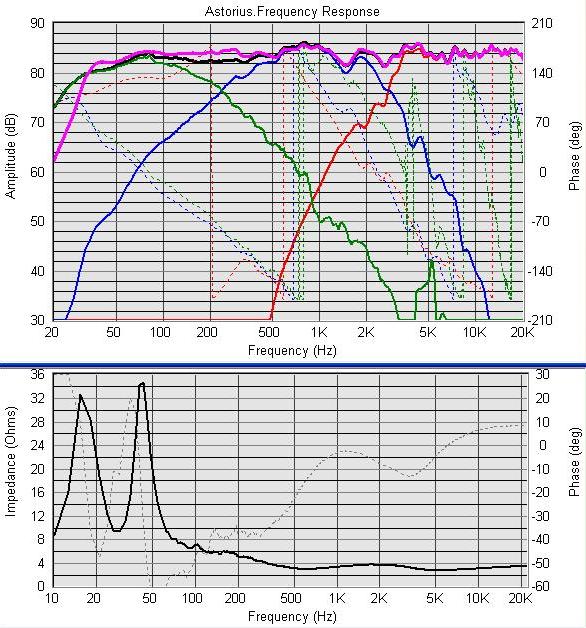 Astorius with RS225Once again I was able to use the original low pass filter of the Daedalus design for this project. Amazingly I was also able to use the same high pass filter as the L22 version. I would use a 16 gauge steel core inductor for the 5 mH value and a 15 gauge air core inductor for the 4 mH value. I would also use 100 uF and 150 uF metallized polypropylene capacitors for both circuits which can drive the price up (use a 50 uF in parallel with a 100 uF cap to get the 150 uF value). If you want to save some money you can use some non-polarized electrolytics for the bass filter but I wouldn't use them for the high pass filter. For the 4.7 ohm resistor use a 9.1 & 10 ohm 10W non-inductive resistor in parallel for a higher wattage combination. As with the L22 version I haven't actually built these cabinets but instead used the original Daedalus cabinet placed along side the Asterions.A plot of the responses is below. The purple trace is the original Asterion two-way design and the black trace is the three way version with the Astorius RS bass unit. The green trace represents the RS225 output, the blue trace represents the filtered Asterion Vifa XT18 output and the red trace represents the filtered Hiquphon OW1 response. As you can see from the plot the bass response is a bit stronger than the L22 version. Compared to the L22 version there is more output in the 100 Hz to 400 Hz range which could be part of the reason why the midrange sounds a bit warmer for this version. These responses could be slightly inaccurate so I tend to trust my ears over the simulation for judging the performance however my listening impressions seem to coincide with the response plots. Also ignore the noisy RS225 response in the region above 1kHz because that is just some inaccuracies of the nearfield measurement and the actual level in this region is much lower (see the Daedalus project measurements for details). The impedance of this design is also pretty flat and is nominally 4 ohms overall. 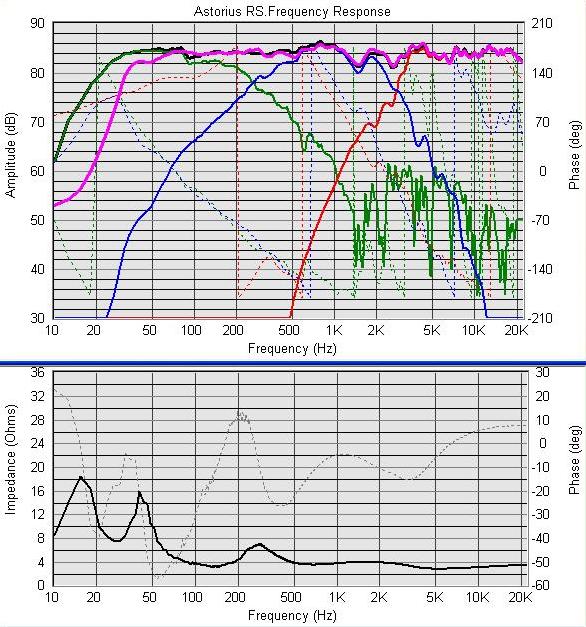 PerformanceBelow is a zoomed in plot of the frequency responses of the three different designs. The black trace represents the Asterion 2 way design, the red trace represents the Astorius L22 three way design and the blue trace represents the Astorius RS three way design.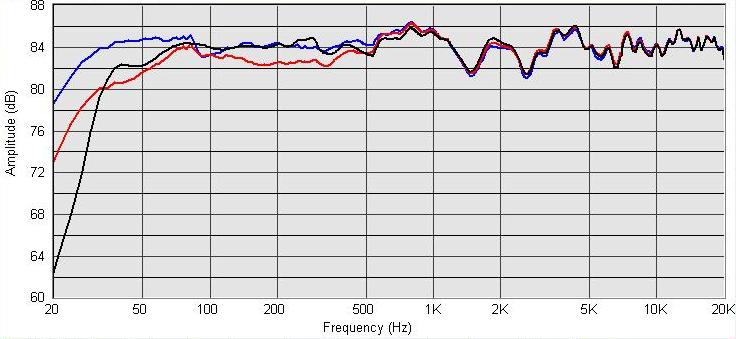 Astorius with L22After comparing the original Asterion design to the three way version with the Astorius L22 bass module I would have to say that I prefer the sound of the three way version. The bass response with the Astorius L22 unit is a bit deeper and stronger below 50 Hz than the Asterion 2 way design. So you do gain a little bit of bass extension with this setup but not much. However, the bass with the Astorius L22 module is much cleaner and more detailed. I suspect that the distortion of the L22 is lower than that of the XT18 in that region. The bass is also much more focused spatially with the Astorius L22 module while it seems more spacious with the original design. The main advantage of using the Astorius bass module in my opinion is the improvement in the lower midrange. The lower midrange is now much more balanced and not quite as strong, definitely an improvement. It is surprising to hear how much the soundstage changes as you switch between versions. The original design sounds a bit more spacious but less precise in the bass region while the three way version has much better imaging in this region. One of the main advantages of the three way version over the original two way is greater power handling because you are no longer limited by the excursion limits of the Vifa XT18 but instead are limited by the power handling of the L22.Astorius RSDue to the higher sensitivity of the RS225 driver this version has a bit more bass overall. The bass is clearly stronger than the original Asterion design. The bass is not only stronger but it is deeper than even the L22 version. This version simulates a bit flatter as well and seems closer to the original Asterion in the crossover region so the midrange still has the warmth of the original design. Although the midrange is still warm like the original design is sounds a bit smoother with less resonance. This balanced midrange warmth gives them a more musical sound that is kinder with rock music and other similar material. They actually have a very natural sound overall. The bass of the RS225 driver is a bit warmer and less dry and detailed than the L22. Some of this could be due to the higher sensitivity relative to the Asterion but some could also be due to extra high order distortion in the L22's output. I suppose most of these observations agree with the frequency response plots I posted. The bass sound from the RS version seems like a better match to the Vifa XT18 driver and provides a more spacious soundstage than the L22 version. Overall this version has the most spacious soundstage but the imaging is still very focused.General CommentsIf you count this as a complete design this is my third (and fourth) three way design. My previous two were based on aluminum coned drivers while this one uses a paper midrange and fabric tweeter. I would have to say that the bass of the L22 integrates fine with the paper (wood-pulp) XT18 as does the RS225. I prefer the sound of these designs over anything I've built so far. They have a much more musical sound than my other three ways and the soundstage is much deeper than anything else I've designed. One advantage to adding these bass cabinets to the Asterion design is it increases the power handling and the excursion limits of the XT18 are no longer the limiting factor to how much power you can feed them. The midrange is so smooth and detailed that they sound good with virtually any source material. They certainly are versatile speakers. These are definitely on the top of my list so far. I'll just have to see if I can top it with my future paper three way design.So which version do I prefer? I'm not really sure. I like the more natural midrange of the L22 version but like the stronger/deeper bass of the RS version. For rock music the RS version sounds better to me but for Jazz I like the L22 version better. It's really a toss up and depends on your preferences and room. If you biamp either design then you will be able to control the bass output independently and might find a happy medium between the two designs (boost the level of the L22 version or cut the level of the RS version). It was nice to compare the performance of the L22 with the RS225 and now I have an idea what the differences are. The RS225 is a bit warmer and smoother and seems to play deeper. The L22 is a bit more dry and detailed and has lower sensitivity. The total cost for a pair of Astorius bass modules will cost just under $400 if you use metallized polypropylene capacitors (around $350 for the RS version). This would put the total cost of the complete three way speaker including the Asterion top cabinets at around $1000 which would make this the most expensive project on my page at this point but they are also the best sounding project on my site at the time. UPDATE: A friend of mine who is an audiophile and offers great second opinion thoughts on my designs listened to both versions of the Astorius. He prefers the sound of the original Astorius with the L22 bass cabinet. There were two weeks between his evaluation of both designs but his comments pretty much match the analysis that I had arrived at. He feels that the bass of the Astorius RS is a bit too "woolly" and maybe too strong. He prefers the tighter, thinner sounding bass of the L22 version but the room may have a slight influence on his conclusion. He feels that the more detailed, better focused bass of the L22 sounds better than the more spacious, deeper bass of the RS version. He also preferred the less warm midrange of the L22 version although did comment that the midrange of the RS version was an improvement over the original Asterion. Now when I evaluated the two different versions there was only a few minutes between switching from one version to the other and I preferred the Astorius RS slightly as reflected in my review above. I still think the best way to implement either design for the best performance is to bi-amp the speakers so you can control the bass driver level independant of the high passed Asterion level. This way you can determine the blend that works best for your room and boost or cut the response below 200 Hz to your liking. With this setup you'll probably want to boost the L22 version slightly or cut the RS version a bit. Even if you get the levels to match between the two versions they will still sound different because the L22 version will still have more detailed, more focused bass while the RS version will have deeper, smoother, more spacious bass. I guess its all a matter of preference as to which one would sound better to you. In my opinion they both sound great but just have a different character. Due to the flexibility of this design you could even build both and choose which base you want to use based on the type of music but this may be a bit redundant if you always prefer one over the other. ReviewsThis is probably the only other review that you'll see for this speaker because it was a temporary design for me using the Asterion speaker along with a bass module from one of my other three way designs. I happened to have the Astorius RS version set up when Jed stopped by to have his Excel three way design measured for future crossover work. Below are his comments.I’ve auditioned a lot of Roman B.’s speakers up to this point, and I would have to say that the Astorius RS225/ Asterion 3-way speaker is my current favorite. One thing that I was a bit worried about when I first looked at the driver selection, was that the metal bass driver might not integrate well with a wood pulp midrange cone and soft dome tweeter. This ended up not being the case, because I think the RS225 woofer has a very full sound that complements the sound characteristics of a paper based midrange driver. The Hiquphon OW1 tweeter was very open and airy which further added to the overall blending of the drivers. If there was one word that I had to use to describe this speaker I would have to say that they are “musical.” I’m really impressed by the Hiquphon tweeter. I ended up using this very same tweeter in my personal pair of speakers that Roman B. helped me design. The Hiquphon OW1 has amazing dispersion characteristics, which I believe adds detail and ambiance where some 1” domes have trouble. The OW1 is a huge contributor to the overall sound of any speaker and is now my favorite tweeter. I’ve used some very high-end tweeters too, including $600 a pair Eton ER4s and Visaton MHT-12s. In Roman’s Asterion speaker, the Hiquphon threw sounds inside and outside the planes of the stereo image and created a you-are-there feeling. The OW1 added just the right amount of sparkle and air without ever sounding harsh. As you can probably tell, I really liked the fact that Roman selected the Hiquphon OW1 for this 3-way design. The Vifa midrange driver was very musical and probably contributed most of the extra smooth and rich qualities of the sound. The upper midrange could have had a bit more presence, but since there were no major peaks it continued to please without attention paid to the somewhat dark quality. Some actually prefer this characteristic while comparing it to terms such as “body” and “warmth.” This exact concept made me question the notion of ultimate transparency and honesty in favor of a musical experience that gets your foot tapping every time, and at the same time, adds “soul” to the music. The Asterion 3-way speaker with RS225 was a perfect example of blending the subtle characteristics of three drivers to create a cohesive and highly engaging speaker. The RS225 is an amazing value, and in some areas I prefer it to my Seas W22EX woofer in my current system. The Astorius bass extension was amazing and it sounded tight and musical at the same time. The RS series of drivers are fantastic in performance when considering their cost. The RS225 is no exception. In fact, in Roman’s application I would have to say the RS225’s slightly less than analytic sound characteristics blended very nicely with the Vifa wood pulp midrange. There was no noticeable overlapping region, rather, they integrated gracefully. That is a feat in itself with identically coned drivers in a 3-way speaker! Again, this speaker is my favorite design of all the speakers Roman has created so far. They are truly full range, offer a huge soundstage, and create enough detail without any harshness. They are suitable for any type of music and allow a highly rewarding listening experience because of the things they do so well. I think Roman’s next speaker should include the incredible bass extension, lush midrange, and smooth treble of this design. Then, he should add a bit more depth, detail, and presence from some of his previous designs in order to make the ultimate statement. Do I see Nextel midranges and 10" woofers in Roman’s future? Jed Kunz |
